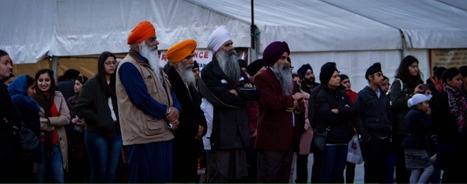Candlelight Vigil in remembrance of the Indian Sikh Genocide 1984

On a glorious late ‘Indian summer’ day on the 1st November 2014 several thousand people milled through the exhibitions and displays from all walks of life from across the Midlands in a very sombre and reflective mood in Victoria Square, Birmingham. They in large numbers were stunned and shocked into a speechless mind numbing state at what they saw, heard and read. For many non-Sikhs this was the first time that they had actually been exposed to the true horror and scale of the Sikh Genocide. One of the many exhibits which stirred their emotions was a large 20-foot black coffin tilted on a lorry with wreaths draped across it, the wreaths were laid in memory of the fathers, mothers, sons, daughters who were brutally and systematically murdered in cold blood in
Delhi and across India during 4 days of state enabled Genocide between 31st Oct – 3rd November 1984 following the death of the then Prime Minister Indira Gandhi, who was shot by her two Sikh body guards.
The scale and intensity of the murders and violence had not been witnessed in India since the 1947 partition, during which the largest deaths were also amongst the Sikhs.
The event on 1st November 2014 was to mark the 30th year of the Sikh Genocide which successive Indian Governments have covered up as nothing more than a ‘riot’ in reaction to the assassination of Indira Gandhi.

One of the guest speakers, Professor Swaran Singh (Commissioner Equality and Human Rights Commission, Honorary Consultant Psychiatrist Birmingham and Solihull Mental Health Foundation Trust, Mental Health & Wellbeing Medical Faculty at Warwick University) shared with the crowds a very moving and personal experience. Swaran Singh was a young surgeon in Delhi in 1984; his eyewitness account left many numb and shocked. Professor Swaran Singh revealed that he was one of the first Sikhs to be physically attacked outside the Hospital in which Indira Gandhi died, he felt a blow at the back of his head, and his turban was knocked off as he fell to the ground. He somehow managed to escape the mobs and make it back to his family residence where they and other Sikh families were the lucky ones as they were given protection by their Hindu neighbours.
Professor Swaran Singh went onto say that large swathes of Delhi was burning, streets and alleys were covered with the burnt bodies of Sikhs in their 100’s. All this said Professor Swaran Singh was not a result of mindless rioting mob, but clear and damning evidence of a state enabled genocide. He said that during 4 days of massacres and rapes the state was largely muted in its response. Professor Swaran Singh then described the horrific aftermath of the Genocide; he and 100’s of Sikh and non-Sikh volunteers faced the enormous task of helping the 10,000’s of Sikhs in the makeshift refugee camps, where he came across harrowing stories which he did not wish to share in public with so many young people in the crowd, that’s how distressing the factual stories he heard and witnessed were. Swaran Singh stayed in Delhi for two years after 1984 and did as much as he could to support the Genocide victims; he then left and set up his future in UK. 30 years on he went back a few weeks ago and relived those dark and unforgettable days, weeks and months of his life, Swaran Singh painted a picture of the plight of the survivors of the Sikh Genocide which beggared belief that after all that the victims had gone through 30 years on there is still a large Sikh Widows colony in Delhi. These widows having lost their husbands and male children in many cases are now left largely to fend for themselves, 1000’s never had a death certificate to be able to able lay claim to their inheritances and thus lost their livelihoods.

Several prominent Sikh figures, Sarbjit Singh a young blogger from Birmingham with Rajoana TV, Cllr Gurdial Singh Atwal, speakers from Sikh Alliance, Dr Bhogal from Sikh Council Birmingham and Sikh Federation’s Dabinderjit Singh echoed the undeniable truths which the Indian Government would rather have the rest of the world not believe; the facts remain unchallenged and the fight for Truth and Justice by Sikhs and non-Sikhs from around the world will continue. The day was brought to a close by a candlelight vigil to remember but never to forget the Sikhs Genocide victims of 1984.
The event also paid homage to the unflinching sacrifice of soldiers, including thousands of Sikh soldiers in remembering the ultimate price that was paid for the aspiration of a free and just society during the Great War of 1914-1918. A contingent of young Sikhs from the Midlands has for several months trained and wore the uniforms that would have been worn by the Sikh infantries in the trenches of France and in places like Burma and other far away campaigns that are often forgotten in the wider commemoration events.

































